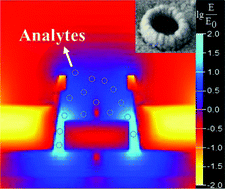Confined surface plasmon sensors based on strongly coupled disk-in-volcano arrays†
Abstract
Disk-in-volcano arrays are reported to greatly enhance the sensing performance due to strong coupling in the nanogaps between the nanovolcanos and nanodisks. The designed structure, which is composed of a nanovolcano array film and a disk in each cavity, is fabricated by a simple and efficient colloidal lithography method. By tuning structural parameters, the disk-in-volcano arrays show greatly enhanced resonances in the nanogaps formed by the disks and the inner wall of the volcanos. Therefore they respond to the surrounding environment with a sensitivity as high as 977 nm per RIU and with excellent linear dependence on the refraction index. Moreover, through mastering the fabrication process, biological sensing can be easily confined to the cavities of the nanovolcanos. The local responsivity has the advantages of maximum surface plasmon energy density in the nanogaps, reducing the sensing background and saving expensive reagents. The disk-in-volcano arrays also possess great potential in applications of optical and electrical trapping and single-molecule analysis, because they enable establishment of electric fields across the gaps.


 Please wait while we load your content...
Please wait while we load your content...